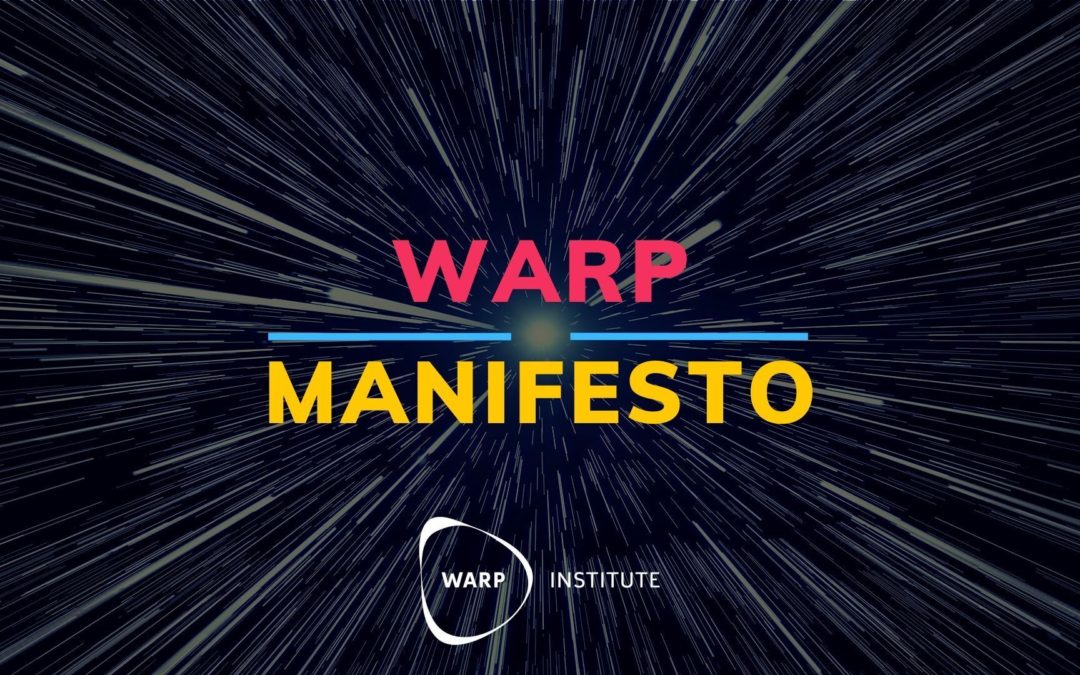Mission: Warp the curve of humanity’s progress
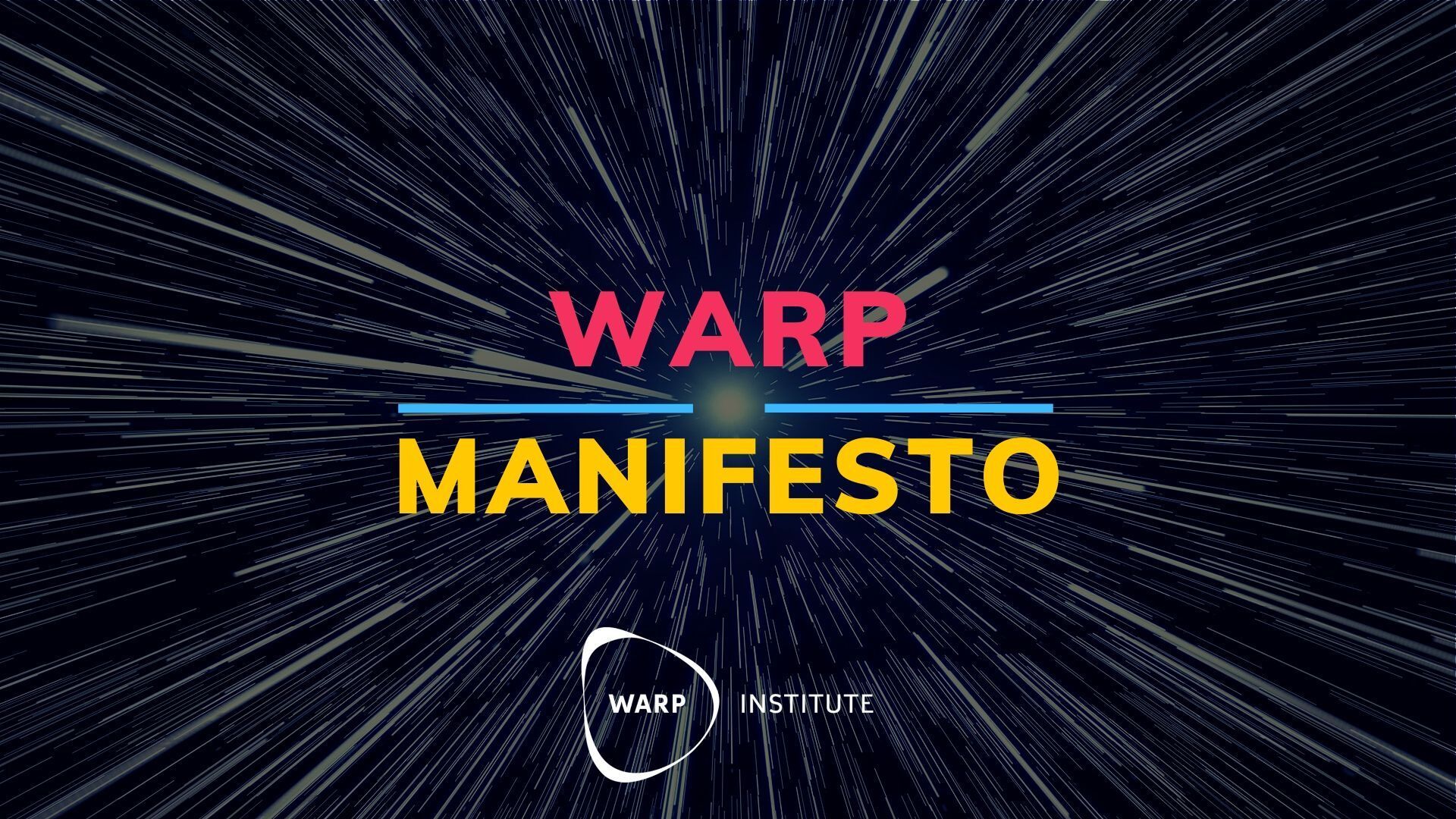
If the curve humanity’s progress had continued at the same rate as it did in the first 2.4 million years we were here on the planet, we would still be sitting around campfires, without clothes, without any tools except primitive stone axes and not even being able to talk to each other.
But we do not sit there grunting, so something must have happened. Development during our first 2.4 million years was very slow, and has been very rapid over the last hundred thousand years.
What happened a hundred thousand years ago was that the curve for humanity’s progress was bent. Development accelerated for the first time in our history.
Since then it has been bent and accelerated several times. Every acceleration has meant that our lives have gotten better. Especially in the last three hundred years. Longer and healthier lives, less poverty, more wealth, more and better food, more freedom and more opportunities.
Therefore, we at the Warp Institute want to bend the curve for humanity again.
It may sound impossible, but we have a secret tool. It was this tool that, for the first time, accelerated human evolution hundreds of thousands of years ago. The tool is old, but more effective today than ever before.
The secret to human progress
For two million years there was no effective way to spread ideas among humans. That is why progress was so slow.
If anyone made a stone ax a little bit better, that knowledge did not spread. He or she lived in a group with around 150 others and they had too few contacts with other groups to have any meaningful exchange of knowledge. Nor did they have any good way of communicating, as they lacked spoken language. If the person with the stone ax slipped and died and had not yet taught anyone else how to make it, the knowledge died out. There was no way to find out again. No one to ask, nothing to Google.
Therefore, human progress was usually one step forward, one step backward.
Until a hundred thousand years ago, that is.
Then, over a period of time, enough groups of people lived close enough together to spread more ideas and knowledge than before. More knowledge lived on, than died out. Two steps forward, one step back.
Knowledge began to accumulate, which meant that new knowledge began to build on old knowledge. Without this breakthrough, we would not have had any of the technology, knowledge and wealth we have today.
Humanity’s secret tool
The secret tool is thus our brain. Or rather, our brains interconnected. An individual brain without access to other brains’ knowledge and ideas is pretty useless. The human brain and body were fully developed long before we reached our breakthrough a hundred thousand years ago. Homo sapiens appeared on Earth about 250,000 years ago. So we had been here for about 150,000 years before our progress accelerated. It was not an improvement of our brains that accelerated our progress. The revolution was that we linked our brains together to a greater extent than before.
“Ironically, our finding that successful innovation depends less on how smart you are than how connected you are, seem is as relevant today as it was 90,000 years ago,” says Dr. Mark Thomas, one of the researchers behind the theory of human development described here.
It is communication between our brains that drives innovation.
If you want to bend humanity’s development curve, you should make it easier to spread more ideas.

Our main innovation is …
Once we started spreading ideas and knowledge, our progress accelerated. We learned how to talk, sew clothes, fish, make boats, sail across the seas. After a little over ten thousand years ago we had learned enough about plants and animals so we could abandon life as hunter-gatherers, settle down and become farmers.
Staying in one place helped the exchange of ideas and distribution of knowledge and soon we lived in villages and cities and created entire civilizations.
Not long after we became farmers, the written language began to emerge and for the first time ideas and knowledge were decoupled from the human body. It could survive and spread outside the human brain.
Books were still extremely expensive until the 15th century, since each book was written by hand. That changed with the printing press and ideas spread like never before.
But we had not yet reached our foremost innovation. It is the innovation that is behind the unmatched wealth increase we have seen over the past three hundred years. For although progress accelerated a hundred thousand years ago, that is nothing compared to what has happened since the 18th century. Since then, our average lifespan has more than doubled. Back then almost everyone lived in extreme poverty, now it’s below ten percent and soon we are at zero.
What innovation helped bend the curve more than anything else?
It’s not the steam engine. Nor is it the industrial revolution.
What bends the human progress curve, which creates innovation, is the distribution of ideas.
Therefore our leading innovation is democracy. The democratic revolution.
In the 18th and 19th century we got the right to our own thoughts and we got the right to spread them. Freedom of speech and democracy linked millions of brains together, whose ideas and knowledge had previously been mostly lost.
This led to an explosion of ideas and a strong acceleration of human progress.
“… successful innovation depends less on how smart you are, than how connected you are…”
Technology help us to spread ideas
Technological development such as clay tablets, papyrus scrolls, roads, printed books and much more have made access to information easier and faster. Since the democratic revolution and the industrial revolution, the technological development of communications has progressed ever faster. Telegraph, the gramophone, the telephone, radio, television and of course the internet. We have also received increasingly powerful tools to distribute the information ourselves with personal computers, laptops, mobile phones and now smartphones.
Increasingly cheaper and better hardware has enabled a single gadget, the smartphone, to give us access to most of the world’s knowledge and half the world’s population. Now we do not need a multi-million recording studio to record audio or a TV studio to make television. We do not need to work on a TV or radio channel to reach an audience of millions. We have blogs and social media to spread the content we produce.
We have come a long way since we sat nude and grunted around a campfire. All because we started spreading ideas.
Why we should warp the curve of progress even more
If you look at history, it is plausible to assume that we could have progressed even further by now. If the primitive democratic society in Athens had developed more and had become a true democracy for men and women with freedom of speech at its core, what would have happened?
Maybe it would have spread to other parts of the world. Maybe we would have had an increase in ideas 1500 years earlier. If that had happened, perhaps the whole world today would have been democratic and all eight billion people lived in freedom.
Imagine how many more brains that had been connected then. As more free interconnected brains mean more innovation, imagine how much more innovation we’ve had. What much further we had come. We could have lived even longer, healthier, richer lives, with fewer or no wars. We had lived on a greener, considerably more sustainable planet. The water would have been cleaner and with less carbon dioxide in the atmosphere. The human suffering considerably less.
If we have made other choices over two thousand years ago, if events would have turned out differently we today could have been further in our progress. And in a hundred years, we can be even further in our progress if we make the right decisions now. If we decide to bend the curve even more, we will live a better life sooner.
The biggest difference between now and earlier in history is that we all have a much greater opportunity to influence the future. One does not have to be a king, queen or even president or prime minister. We all have the opportunity to impact the future. Not just our own lives, but everyone’s.
How we will bend the curve
What is needed to bend the curve is more ideas and better distribution of these.
Consequently, the entire population of Earth must live in democracy. Because it automatically gives them a better life and because it is morally right, but it also has the positive side effect of improving the rest of the world as well.
We also need to continue to develop and share the techniques that enable the distribution of ideas. Everyone needs to have access to computers, smartphones and whatever communication technology comes after this.
However, we do not have to wait for this to happen before we can begin to bend the curve. Thanks to the Internet, it is now possible to create global communities that will have more power to shape the future than anything else in history.

The Age of Communities
Despite the Internet, the world is still dominated by centralized institutions. Security Councils, governments, central banks, corporate boards and municipal boards. Representatives are appointed by the people or by people whom the people have appointed.
It has been a successful model. because it solved two problems. First, an information problem. Information used to travel pretty slowly. Second, the difficulty of letting large groups of people vote often. We manage elections every few years, or in a company or association once a year, but more often than that is pretty complicated. Therefore, it has been smarter to appoint representatives.
Digital development and the internet have solved these two problems. Information travels fast and in abundance and it is no longer particularly difficult to allow many people to vote often.
Therefore, we will be able to see huge communities grow, which are controlled and financed by the people in them. One million people who spend $10 a month, as much as a Spotify subscription, gives an annual budget of $120 million. Despite a small financial effort by each person, there combined budget will be big.
The main strength of this kind of community is not the combined budget. It is the distribution of ideas. With one million members from all over the world, there will be people with every conceivable kind of background, culture, education, age and gender. But since they share the same kind of basic values and direction, it will be an effective tool for that kind of progress.
Of course, one million people is a lot. To build that large of a community is hard. At the same time, in a world of eight billion people where half of them are on the Internet right now, one million is not much. In some cases, this type of global community will be even larger. Many million people, maybe even hundreds of millions. Their power will exceed the most powerful centralized institutions that rule the world today.
Optimists creates the future
If we can make more people optimistic about the future, that could have a big effect on the future. We know this because science shows that optimistic people generate more ideas and are more open to the ideas of others. Those people are also more likely to take more action on those ideas, and make something of them. When they face problems or obstacles they are less likely to give up. And if they fail and can’t get the idea to work, they are more likely to try again with a new idea.
Imagine a society with a majority of optimists. Lots of ideas, lots of entrepreneurs and a ton of new progress.
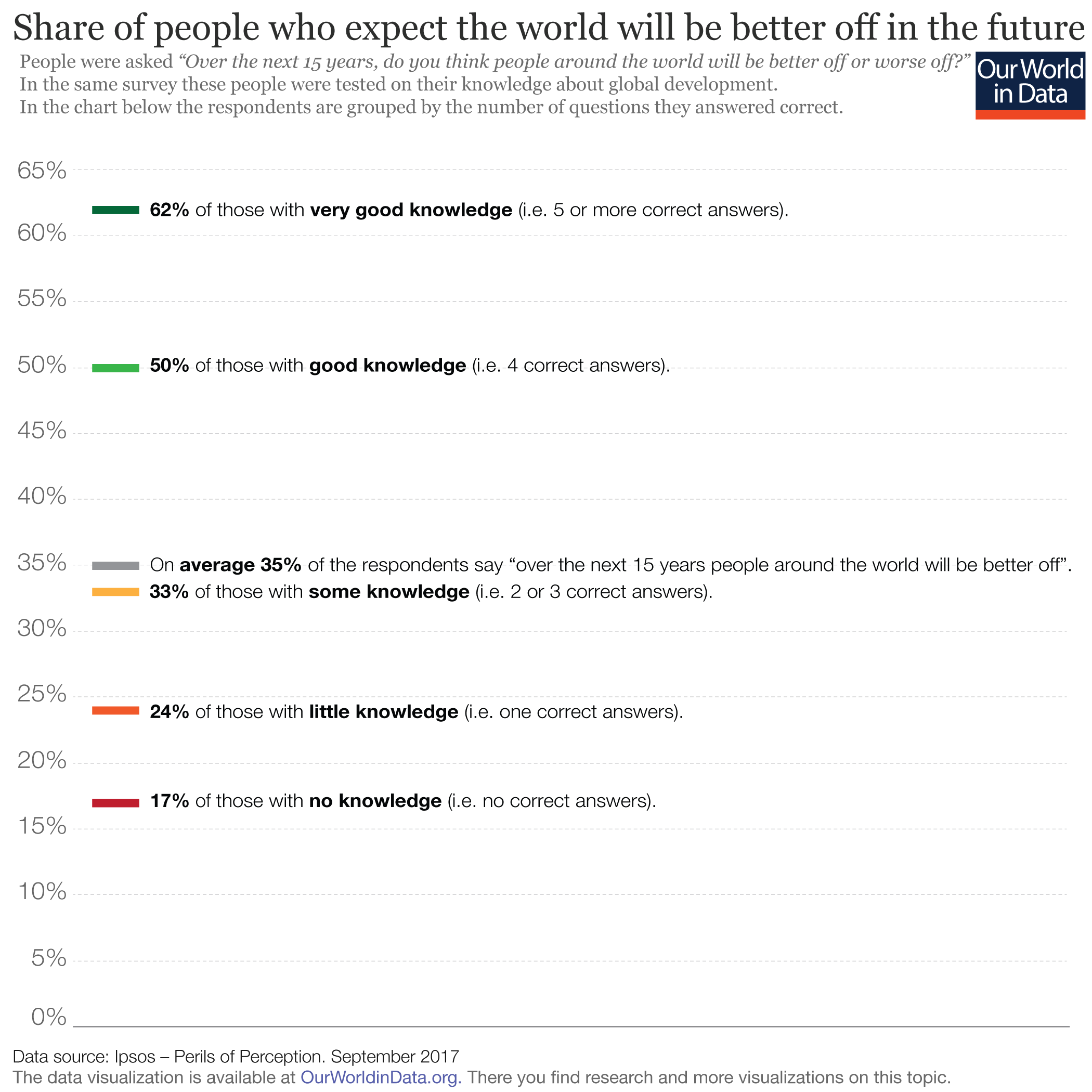
A plan to warp the curve
Warp Institute is a foundation based in Stockholm, Sweden that is also located in the United States, in Raleigh, North Carolina. The foundation’s purpose is to warp the curve of human progress and make a better future come sooner.
We intend to do that in three steps, which can be likened to building a three-stage rocket. The first step is the production and distribution of fact-based optimistic news. The second step is the community. The third step is to take the most important ideas out of the community and make them come true.
When you build a rocket, you do not build every part individually and hope that they fit together. The entire rocket is built at once, but with the most focus on stage one.

Step one – fact-based optimistic news
The bottom of the rocket is the largest. So even in this case.
By producing and distributing fact-based optimistic news, we help make people more positive about the future. We balance the negative overweight in other news media and contribute to a more realistic view of reality.
It also has the positive effect of gaining followers in social media, subscribers to our newsletter, attendees at events, listeners on podcast and viewers on YouTube. The better we are at connecting these people, the more of a community it becomes.
Step two – community and WIP
To use the collective intelligence – the wisdom of the crowd – we crowdsource our followers. Ask them to answer questions and come up with ideas. For example, who should be nominated for an award as Optimist of the Year, or which companies have exciting projects for a better climate.
Some of those who follow us in different ways will become more active and involved. They come to events, get to know other warpers and some of them become volunteers.
We have been gifted from the beginning with very good volunteers. They are all optimistic, forward-looking and solution-focused. Which is not strange considering the context, but such an environment is contagious to be in. You want more.
It is important for our community to become global. It is the mix of people from all corners of the world that will give birth to the really exciting ideas.
Step Three – moonshot ideas and projects
The most famous ‘moonshot’ was John F. Kennedy’s promise to place a man on the moon before the end of the decade. A moonshot is something so big that it changes the direction of humanity. Warps the curve for humanity’s progress.
In a global community filled with entrepreneurial, optimistic, forward-looking people, many moonshot ideas will be born. And the great thing is that everything to implement these ideas is found in the community. All knowledge, all contacts, the money. Everything. With a million people from all over the world, there is no door that cannot be opened.
The most active members, WIP (more about them below), will decide which of these moonshots Warp should invest in.
We’ll report on these moonshots in Warp News and distribute them in our channels, which shows what is possible to do in a global community and makes the community even more optimistic. Which in turn attracts more people to our community.
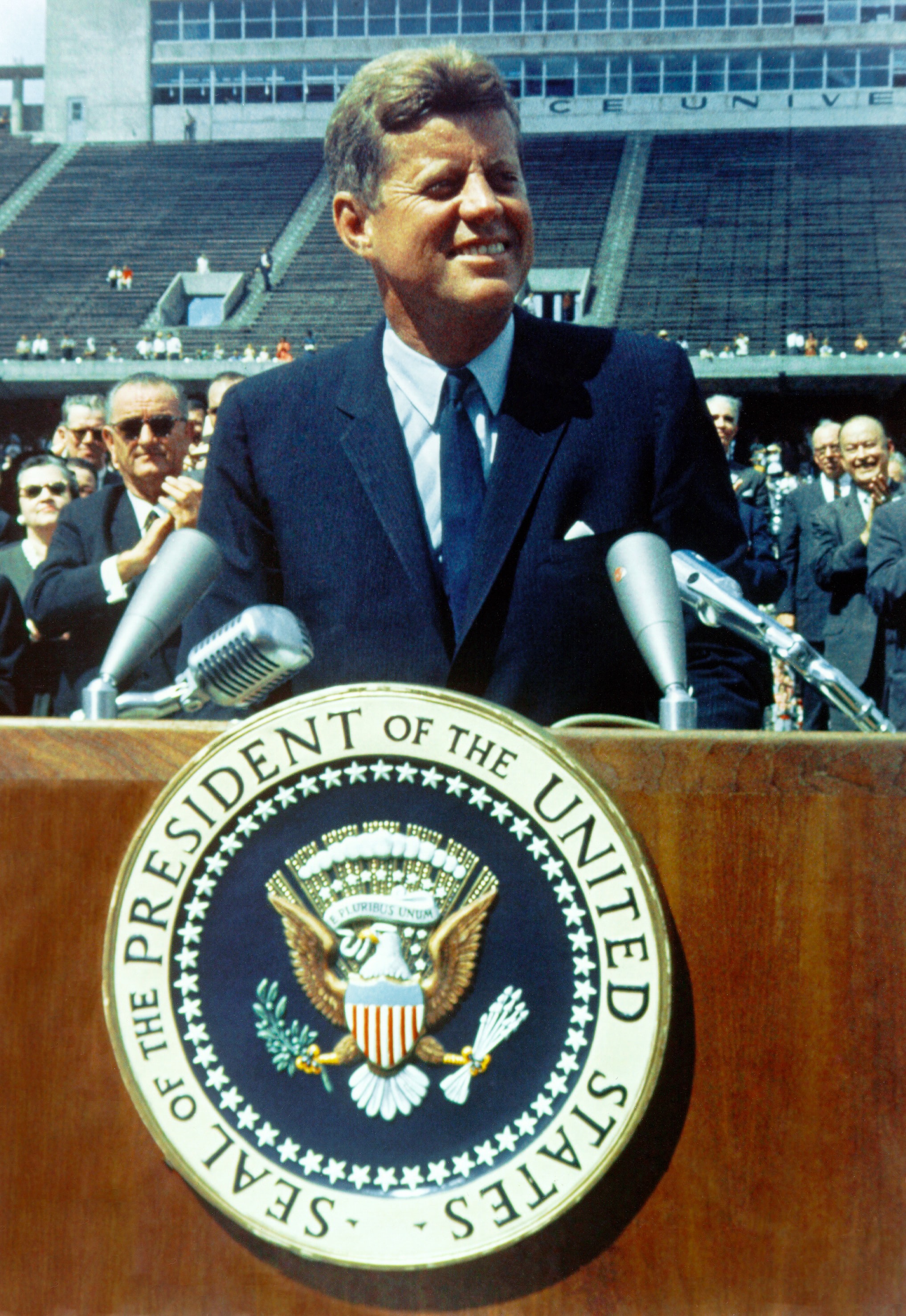
A vision for the world
There are plenty of dystopias for the world, not least from Hollywood. Terminator, Bladerunner, Minority Report, Water World, 2001, A Clockwork Orange, 1984, Ready Player One, Handmaid’s Tale… But how many utopian movies can you come up with? Where people live in a better society, a cleaner and richer world? I can come up with one: Star Trek.
Outside the world of film, there is also plenty of doomsday prophecies.
Parts of the environmental movement that derive their intellectual foundation from William Vogt’s apocalyptic environmentalism have a clear vision, but it is a negative one. They want to set boundaries for human existence on planet Earth and then retreat back within them. Not by innovation, but by cutting back.
There are a lot of positive visionaries around the world. Elon Musk works to transition the transport fleet from fossil fuels to sustainable energy and colonize Mars. Boyan Slat works to clean up all plastic from the oceans and rivers. Anousheh Ansari opened the door for private space travel. Malala Yousafzai created an international movement for human rights.
We need even more visionaries, but above all we need a unifying vision. Where does humanity want to be in 20, 50 and 100 years? In 500 years? In 1000 years
The Warp community will have a constant discussion about this. What unites us is th Warp community that we want to move forward, we do not want to go back. We believe in ideas, science and innovations. We want progress to go faster. We of course differ in many opinions, otherwise it will be a very boring community and not very creative community. But we will also gather around some big goals, a vision and what it more means to warp the curve.
Vision becomes an action plan
From a vision, you can pick goals and projects that need to be implemented to get there. An action plan. (Sorry, I’ve been a politician, we love action plans.)
Take space as an example. If millions or billions of people are to be able to live in the solar system and not just on Earth, lots of resources are needed to do so. We need energy and building materials. If more than a few hundred people are to be able to live permanently in space, we cannot send these resources from Earth. It will be too expensive and would also be a waste, since the resources could be found in abundance on asteroids.
We thus need to learn how to use these resources in space. The first step is to identify which asteroid is best suited for our specific purpose, which today is very expensive. So we need to make it less costly.
That is the goal of Beyond Atlas. A Swedish project aimed at completing the first private mission to an asteroid. If they succeed, the cost of exploring an asteroid will fall by 99 percent.
That is why we at Warp decided to help them achieve that goal. We have started the Warp Space Program, whose vision is that humans should live out in the solar system, that our future is among the stars. Beyond Atlas costs about $ 3 million to complete (the second “cheapest” asteroid mission is $ 800 million.) We will crowdfund that needed amount.
So far (May 2020), $ 1.6 million has been funded, which means that the test mission is fully funded and launches in June 2020. In August 2020, we will gather 1200 people at the Warp Space Summit to discuss the future of humans in space. If we are to have a society in space, we can’t only rely on the engineers, we must have all kinds of people. Teachers, biologists, political scientists, entrepreneurs, artists, writers, programmers, politics … well, maybe not politicians.
If Beyond Atlas is successful, we have taken a small but important step to enable human life in the solar system. We have bent the curve a little. Then we together figure out what the next step is, support that, and bend the curve a little further.
Warp is not only space. We need to figure out how to do this in many different areas.
A global community
Shared knowledge
In order for ideas to have the maximum chance to be born, they need to be fertilized with knowledge. The news from Warp News forms the basis of that. They are about innovations, research breakthroughs, exciting projects and statistics on positive development in the world.
As Warp grows, so does the opportunity to not only write about news, but also analyze and understand the present and future. Knowledge that you only can get from expensive consulting firms, will be available to everyone in the Warp community.
Events
An opportunity to meet other warpers and make personal ties is meetups, conferences and other types of events.
These events also give us a good opportunity to spread knowledge and ideas to the people attending, but also via video, podcasts and articles to those who could not physically attend.
By being diligent organizers of events around the world, we build up a strong competence and can develop the sometimes tiring concept of conferences.
A Warp Olympiad
Every program in Warp – Warp Space Program, Warp Green Tech and Warp Future Health and several others in the future – will arrange a large Summit at least every two years. There may also be Summits for an individual country or region.
Every four years, all Warps programs come together for a huge Summit – Make the Future Come Sooner Summit. There, the different programs meet and you get new perspectives. This is when the chance for really interesting ideas is the greatest. When normal thought patterns are disturbed by others and you see how techniques and ideas converge.
The reason for holding this big Summit only every four years is the same reason the Olympics is every four years. It will be a bigger event, more important to win a gold medal there than in the World Cup that takes place every year. All the most interesting speakers can attend and the attention gets bigger.
At each MTFCS Summit, you look ahead and discuss how you can make the future come faster, focusing on the four years to come. Also, a look back at the last four years. What did and did not happen as we thought four years ago, and what can we learn from that?
Decentralized power and the improvement of democracy
As mentioned, the world is still dominated by centralized power where representatives are appointed to make decisions. This model has many advantages and will certainly live on, but more power will be transferred to decentralized organizations where more decisions are made by the members.
Warp Token
We intend to use a token-based on a blockchain. A token gives you rights within the Warps community and votes when Warp makes important decisions.
For example:
If you are a WIP you pay ten dollars a month and get ten tokens or ten votes. Lets say you joined in January and in August there is a vote on which project we will support within the Warp Space Program after successfully supporting Beyond Atlas. They made their way to the asteroid, now it’s time for the next step. You have been WIP for six months and have 60 votes.
But not only did you pay your membership fee, you went to three meetups (five tokens each) and invited four people who became WIP (20 tokens each) and also provided a connection to a company for a project within Warp (ten tokens). Behavior that improves and strengthens the Warps community will be rewarded. It will not be possible to buy more votes than the membership fee gives.
In total you have 60 + 15 + 80 + 10 = 165 votes.
These 165 votes yoou can use in the poll for which space project Warp will support.
The great thing about a blockchain-based token is that we can develop it as we progress. And that is what we intend to do, as we learn what works and what doesn’t.
It may seem like a stretch that this will affect democracy in the world, how nations are governed, how nations develop. But it isn’t. Thousands of different communities will experiment with different ways of being governed and that the nations can learn from.
WIP – Warp Important Person
The membership in Warp Institute is called WIP. It is for Very Important Persons, but not based on wealth or celebrity, but instead that you are an optimistic, forward-looking person who wants to contribute to the improvement of humanity. It is open to anyone in the world who shares these basic values.

The low fee gives more value and more money
Given the value you get from the membership, the price could be very high. Many business networks charge thousands of dollars per year. Instead WIP costs ten dollars a month, or 100 dollars a year. The reason is that money should not be an obstacle to join. Not just an economic elite should be able to join, but all people.
The low fee will also make Warp’s budget much larger. It may seem paradoxical, how a lower sum gives more money, but the answer lies in the number of people. Networks with high fees become small. Networks with low fees but with great value will be large.
The world’s most valuable network
Money is important in order to carry out projects, but the greatest value in the WIP network is the people. Their ideas, their contacts, their knowledge. A mix of people from all over the world.
WIP will contain the most exciting people you can find on this planet. (And hopefully in a not too distant future on other planets in the solar system as well.)
Contribute to Warp’s projects
The money from WIP goes directly to Warp’s different programs and projects.
Of the 10 dollars each month:
- 5 dollars go to Warp News
- 2 dollars to WIP events and Warps administration and management
- 3 dollars go to the jointly decided projects
These projects are crowdsourced by our large community. We ask them for suggestions and our volunteers review the projects and the management decides whether they are in the spirit of Warp and contributes to Warp’s vision. After that, all WIPs vote and decide which project will receive support in the coming time period.
As we grow and the budget gets bigger, the share of the money that goes to Warp News will fall. The editorial staff should not just increase in size, but kept as narrow as possible to deliver the highest quality. Similarly, as we grow, the share of administration and management will decline.
Knowledge about the future
Our WIPs get access to premium content, where we analyze and comment on new technology, other progress and its impact on society.
Today, the premium material consists of a longer WIP article once a month, on topics such as self-driving vehicles, Wrights law, green technology, how economic growth and reduced raw material consumption go together and the future of local journalism in a digital world.
Several times a month, shorter comments and analyzes are published on current events.
Many people think we live in a linear world, when we actually in many cases live in an exponential world. If you think the world is linear, you risk being Kodak. Inventing the digital camera, but completely missing when it will have a huge impact and undermine your current business model. If you understand exponential growth you’ll stay ahead of the curve.
As WIP grows, the range will be expanded with podcasts, videos and more and more comprehensive analyzes and comments.
Warp Important Person
The Warp Institute’s main source of income will be the WIP memberships. Our means to spread fact-based optimism will come from the WIPs. The WIPs will contribute more than any other people to warp the curve of humanity.
Therefore, Warp Important Person is a suitable name.
Warp News
The world has become much better in recent decades. At the same time, the media’s portrayal of the same world has become increasingly negative. In Steven Pinker’s excellent book, Enlightenment Now, he refers to Kalev Leetaru’s analysis of the tone in news in 130 countries between 1979 and 2010. A period when, among other things, we saw child mortality fall dramatically, more people leaving extreme poverty than ever before and the internet made huge amounts of knowledge available to billions of people, for free.
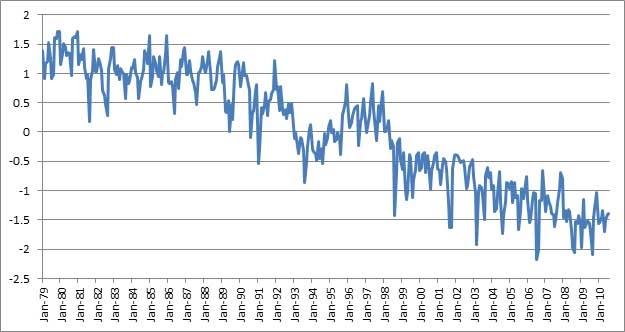
This is probably a strong contributing reason why 90 percent of Swedes and 94 percent of Americans do not believe that the world will be better in 15 years than today.
With Warp News and fact-based optimistic news, we help balance this imbalance. We write articles on the Warp News website, send out a newsletter every week, produce a podcast and distribute the content on social media.
Warp Space Program
To live where no human has lived before. We want to contribute to the future of humans in the solar system (and beyond.)
Humanity has always strived forwards, and it would be odd if we were left alone on earth forever. Finding us more places on planets, moons and space stations would be the greatest adventure ever. The moment when we have a self-sufficient presence on another planet would be the greatest momemt in the history of humanity.
We want to be part of that and contribute to that. And nowadays, it’s not up to the superpowers or the nations alone, we can all join and become an even stronger force to accelerate humanity’s future in space.
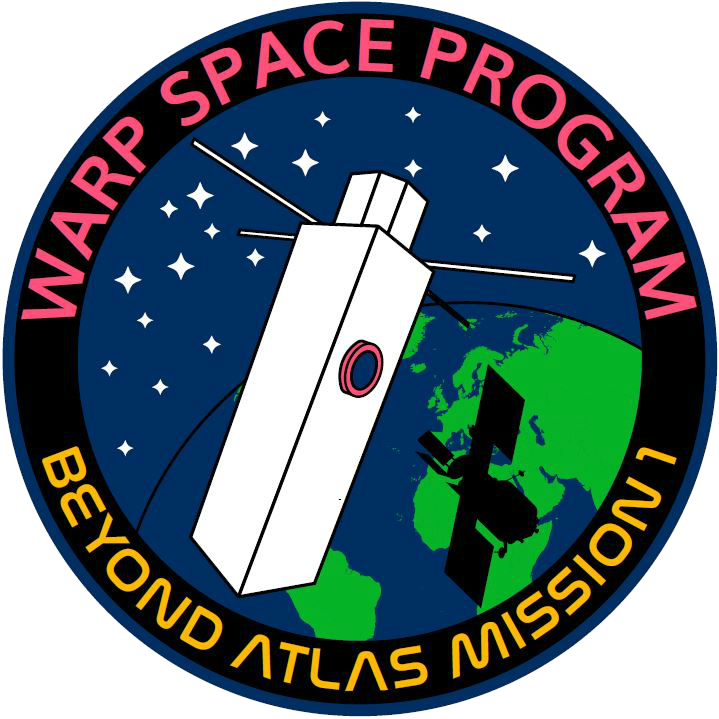
Warp Green Tech
Climate change is one of humanity’s worst problems, but we are convinced that we will solve it. Once we have done that, it will be one of the greatest achievements in our history.
It will not happen through more talk about the doomsday. Nor by moving backward into the future. The solution is ideas and innovations. These come from the small and large efforts of millions of individuals.
At Warp Green Tech, we highlight these innovations, support those who seem most promising and work to find even more.
Warp Future Health
If you are a Swedish woman and have lived in Sweden since the 1950s, your life span has been extended by one year every four years until today. Since the industrial revolution, we have more than doubled the global average life span, from about 30 years to 72 years today.
We think that’s just the beginning.
Now there is exciting research about aging. Is aging a natural process, or should we rather see it as a curable disease? Much indicates the latter.
We want to contribute to warping the life curve. Instead of an extra year every four years, an extra year every two years, every three years, every four years … until we reach longevity escape velocity. The point when life is extended more than time passes.
Does that sound like science fiction? It does for me. But it can become a science fact.
The Warp Fund
Projects that warp humanity’s progress may sometimes need funding. Often venture capital goes to companies with the greatest ability to make a lot of money, but in recent times, impact investing has become increasingly popular. Companies that make a clear benefit to our lives and the planet.
Trine is one such company. Private individuals can invest money in solar cell projects in countries where there is a lack of energy and, above all, clean energy. Through their investment, people in poor villages receive electricity and, for example, do not have to use fires indoors, with the damage it causes to them and the planet. Each investor receives a five to ten percent return on his money. Everyone wins.
This type of company is what Warp should support.
Venture capital does not only have to come from venture capital companies. Crowdfund investments are growing rapidly.
We want to create such a fund.
Fact-based optimism
Warp Institute stands for fact-based optimism. We look at the facts and see that 1) most curves for humanity point in the right direction and 2) we have cracked the code for how we create positive progress.
The code for progress is:
Free ideas – allowing people to think freely in democratic societies.
Innovation and technological development – makes it easier to spread these ideas.
This means that the problems that exist are possible to solve.
How can one be an optimist with so much suffering?
Being a fact-based optimist does not mean denying what is bad in the world. Millions of people live in extreme poverty and under oppression, but it gets better, not worse. Since 1990, 137,000 people have left extreme poverty, every day. The proportion and number of people living in free societies have increased.
There are plenty of sources showing the positive progress of humanity, among which we recommend Enlightenment Now by Steven Pinker, Factfulness by Hans Rosling and Our World In Data by Max Roser.
How can one be optimistic when climate change threatens us?
Climate change is a serious problem for humanity, but a problem that we are convinced can and will be solved. In the same way that we solve other problems, with innovation and development.
We want to speed up this development by showing that an environmentally sustainable society means a better life, not worse. We don’t have to retreat, or lives don’t have to get worse. For example, energy from carbon-free sources creates fewer emissions, is cleaner and is already in many cases cheaper. To transition to that is something that makes life better.
Why are so many negatives to the future?
In the US, only six percent believe the world will be better in 15 years. In Sweden, ten percent. 94 and 90 percent, respectively, believe that the world will be worse or at least not better.
They believe that the positive progress we have seen for hundreds of thousands of years, and especially in recent decades, will reverse and suddenly become worse. Of course, this could happen, but it’s highly unlikely. Most likely, positive progress will continue. Not everything will become better all the time, that would be magic, as Steven Pinker says. But overall, the world will become better and better.
So why do many people believe the future is bleak? Because many don’t see the progress we’ve made. And if you think the world is getting worse, you think the future will be even worse. A lot of people get this view from all the negative news in the media. Therefore it’s so important that we build Warp News into a big, international news source to balance the negativity and show people how the world is actually progressing.
If we succeed, more people will have a fact-based view of the world, and be more optimistic about the future. That will make them more eager to be part of creating that future and warping the curve of human progress even more.

